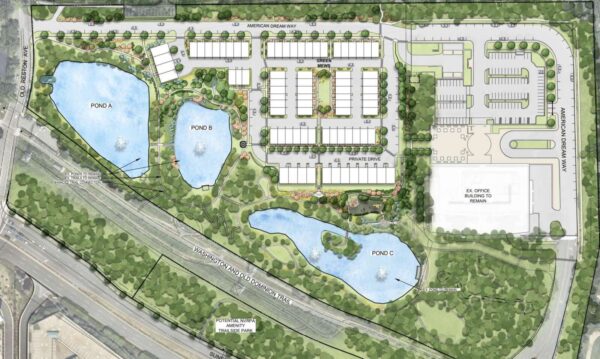
A previously approved plan for the redevelopment of the former Fannie Mae campus in Reston is once again headed before the Fairfax County Board of Supervisors for a vote on an expedited timeline.
At a board meeting on Tuesday (June 28), Hunter Mill District Supervisor Walter Alcorn successfully passed a board matter to move the application from developer Wheelock Capital for an official vote by the board as soon as possible.
The plan includes 74 townhouses and eight two-over-two units on the 28-acre property, which is currently developed with an office building that was once home to mortgage company Fannie Mae. The building would remain undisturbed by the plan.
In a 9-1 vote, the board approved the project in August 2022, but the approval was voided when the applicant “missed a payment deadline associated with its buyout obligations under the Dulles Rail Tax District,” according to Alcorn.
“As Board members may recall, this rezoning permits the construction of townhouses in lieu of another high-rise office building on the site,” Alcorn’s board matter states. “The rezoning was negotiated extensively with the community and county staff, and if ultimately built will provide a number of environmental and public benefits.”
The applicant also received the county’s permission to process its site plans — which have already been under review for several months — concurrently with the reapproval of the overall project.
The residential units will be located on the northern end of the property. Existing access points off of American Dream Way will be realigned, and two additional access points will be added to serve the residential development.
A private road system and connections to Reston’s trail system are also proposed. A new sidewalk will be constructed along the Sunset Hills Road frontage to the property, as well as a modified intersection at Sunset Hills and American Dream Way.
While the board matter doesn’t specify a date for the vote, the county’s zoning applications database indicates that a Fairfax County Planning Commission meeting has been scheduled for Sept. 13, and a board public hearing will follow on Sept. 26.
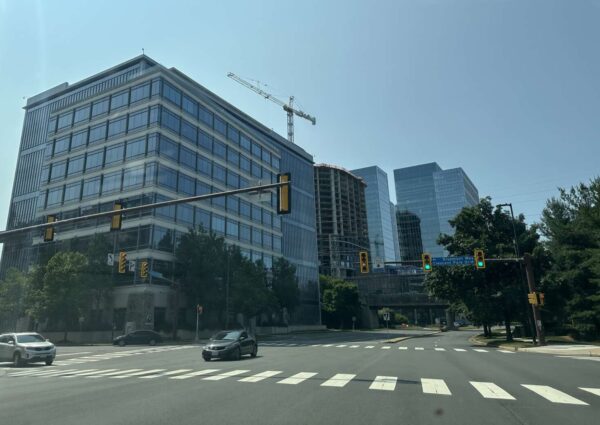
The Fairfax County Planning Commission unanimously deferred a decision on the Reston Comprehensive Plan overhaul at a public hearing Wednesday (June 14) night.
The move — which delays a vote to June 28 — came as public testimony at the hearing centered around a challenge facing Reston: navigating growing pains as it chases a new transit-oriented future while also trying to preserve its past.
Hunter Mill District Planning Commissioner John Carter said county staff and the commission will release a new document that outlines community requests by chapter, staff responses and the commission’s decision on each item.
“We’re going to be working hard in the next couple of weeks,” Carter said.
Some residents and community organizations asked the commission to defer a vote because they needed more time to review a supplement to the plan that staff released on June 13, one day before the hearing.
“We are still pouring through the 25-page addendum,” said Lynne Mulston, president of the Reston Citizens’ Association.
Notable revisions in the addendum include a recommendation that multifamily housing be allowed anywhere in Reston’s transit station areas, not just within a half-mile of the Metro stations, and language encouraging the addition of affordable housing, not just the preservation of existing units.
Underway since 2020, the Reston Comprehensive Plan update lays out the county’s vision for the 6,750-acre area’s development, touching on everything from transportation to density recommendations for the transit station areas and village centers.
The proposed draft was shaped by county staff and a community task force convened by Hunter Mill District Supervisor Walter Alcorn in 2020.
Speakers overwhelmingly opposed a proposed vehicular connection between North Shore Drive and Sunset Hill Road via American Dream Way. Citing concerns about traffic safety, residents argued that the proposal would turn North Shore Drive into a thoroughfare and cut-through street.
“It would be highly unsuitable and dangerous for North Shore Drive to become a thoroughfare,” said local resident Christopher Bean.
Another resident who took issue with the proposal said he moved to the area to have a place for his daughter, who stood alongside him as he testified.
Speaking on behalf of the Greater Reston Chamber of Commerce, Mike Jennings emphasized that the task force did not reach consensus on the version it produced.
Jennings said a tie vote on the initial plan was broken when an abstaining member shifted the vote in favor of the plan. He called staff’s version of the plan a “significant improvement” because it trimmed down “erroneous,” “impractical,” and “prescriptive” language.
Trimming the task force’s version of the draft plan from 180 pages to 133, county staff’s version is intended to avoid prescriptive language in specific areas, especially land use, that could conflict with countywide policies. Initially separate chapters about equity and community health were consolidated into one chapter related to “new town” elements.
The plan also covers Reston Town Center North — an area that is in limbo but is also slated for major redevelopment. The proposed draft recommends limiting residential development to 1,000 dwelling units with all new market rate units consolidated on three blocks. The remaining four blocks would have up to 150,000 square feet of nonresidential development, including civic and public uses. Read More

The Mosaic District is hanging up its roller and ice skating plans — at least for now.
The Fairfax County Board of Zoning Appeals (BZA) agreed Wednesday (June 14) to indefinitely defer Rink Management Services Corporation’s request for a special permit that would allow it to operate a skating rink in the Merrifield neighborhood on a seasonal basis.
This is the sixth deferral of a decision on the application since the board held a public hearing on July 13.
“This case has been a bit of a moving target,” said Brent Krasner with the Fairfax County Department of Planning and Development. “…At this point, after conversations with the applicant, I think they are reevaluating their plans for these types of activities, both the winter ice skating and summer roller skating activities. Essentially, their plans are not settled yet, and so they agreed that an indefinite deferral was the best route.”
First submitted back in April 2022, the proposal from Rink Management and EDENS — the developer that owns the Mosaic District — sought to turn the Mosaic Skateland roller rink that popped up during the past two summers into an annual occurrence.
Going forward, roller skating would be provided for 90 days each year from April to the end of June. During the winter months, an ice skating rink would be provided instead.
The operator estimated that the rink would draw approximately 15,000 skaters each season, according to the application.
However, at the public hearing, community members raised concerns about noise, traffic and access to their homes, and the BZA suggested the applicants’ public outreach efforts were insufficient.
Earlier this year, county staff confirmed to the BZA that Mosaic Skateland wasn’t going to return this summer, but Rink Management and EDENS left open the possibility of ice skating. Now, that has also been taken off the table.
“If they decide they’re going to go ahead this winter, they would let us know and reactivate [the application] — or next spring for example — but at this point, they don’t have any immediate plans,” Krasner said.
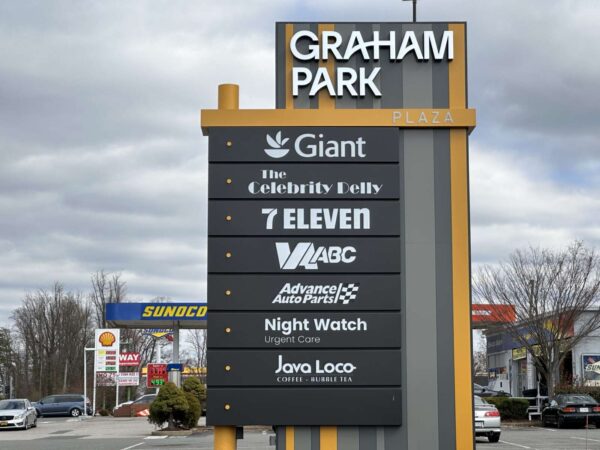
Fairfax County is looking into adjusting its signage rules to allow for brighter and bigger electronic signs.
Casey Judge with the county’s Zoning Administration Division presented the proposed changes during a Board of Supervisors land use policy committee meeting on May 16.
The changes include increasing the maximum brightness for nonresidential districts to 300 nits (a unit that measures the brightness a sign is emitting) at sunset. Current regulations require electronic signs to automatically dim to 40-100 nits at sunset.
The changes also includes requiring sign permit applicants to submit sign specifications.
In addition, the three existing application processes that the county currently has for nonresidential areas could be consolidated into one process.
“This does mean that all sign applications would go to the board for approval rather than the current [comprehensive sign plans],” which only need to be approved by the Fairfax County Planning Commission, Judge said.
Proposed modifications for electronic display signs with special exceptions include increasing the number, height, and size of freestanding signs, allowing building-mounted electronic display signs, and increasing the brightness to 600 nits.
Last May, while discussing the matter, county staff told the committee that the existing rules are old and that businesses wanted to be more competitive. Judge also suggested that easing the application process could be helpful to businesses.
Hunter Mill District Supervisor Walter Alcorn, the committee’s vice chair, questioned how the county is handling the convergence of “what’s a sign and what’s a display.”
“These things that we have traditionally dealt with as signs are being used in other means, or for other purposes,” Alcorn said.
Judge said a standard has been added that focuses on traffic safety and overall placemaking effects as part of the electronic display signs.
“I do hope that that standard can help guide our staff when they’re making that analysis to ensure that we’re looking at size and location, more so than the content in making our recommendations,” Judge said.
Braddock District Supervisor James Walkinshaw questioned the proposed increase from 100 to 300 nits, which he called pretty significant.
“That’s really in response to research looking at other jurisdictions that have much higher nit level limitations and it allows for those higher definition screens that we’re seeing,” Judge answered.
Judge said the county is seeking authorization and public hearings later this year.
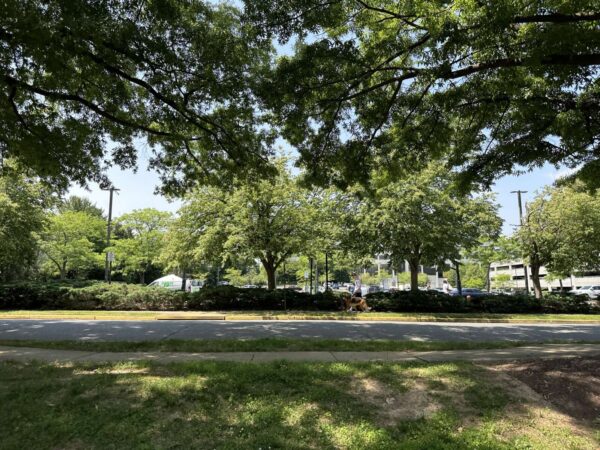
Fairfax County’s parking lots and streetscapes could look a little greener.
At a land use policy committee meeting on May 16, planning staff proposed a new update to the county’s landscaping and screening ordinance — the first major change in 40 years — that would make developers add more green landscaping to more parking lots and street frontages.
For parking lots, the current ordinance requires trees to be installed at any surface parking lot with 20 spaces or more. The new ordinance could expand that requirement to any lot with 10 parking spaces and increase the amount of tree coverage from 5% to 10%.
New parking garages, meanwhile, would be required to have 10% of their top decks covered with shade, although utilizing solar canopies could lead to a reduction in that percentage.
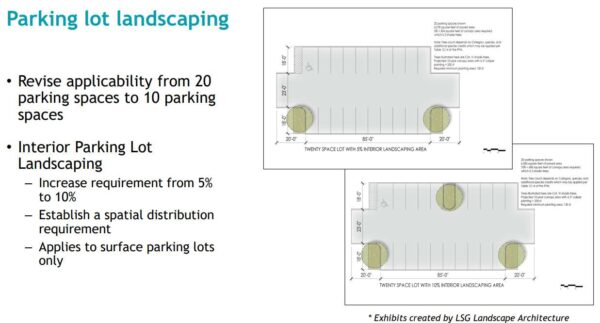
The ordinance also introduces “street frontage landscaping” — requiring developers to provide trees on private property provided they’re along private or public streets, not internal drive aisles. Single-family dwellings would be exempted.
One small but meaningful change would also adjust the types of trees seen in these green spaces, as it turns out Fairfax County’s previous specifications weren’t evergreen.
“When it comes to transitional screening a lot of waivers are applied for to use existing vegetation because they have to have 70% evergreens and that’s not common in Fairfax County,” Sara Morgan, a planner with the Department of Planning and Zoning, said. “This allows us to review [developments] on a case by case basis as we want to further encourage the use of existing vegetation, allowing you to have a mix that is different than [the ordinance] today if you retain existing vegetation.”
Similar to the zMOD update approved in 2021 — then reversed and reinstated earlier this year — county leadership said the landscaping and screening ordinance update is a good step forward on fixing some outdated code.
“It’s been 40 years since we updated these,” Board of Supervisors Chairman Jeff McKay said. “I think this is overall very, very good.”
The board approved new tree canopy standards earlier this year with the hope of encouraging private developers to plant more street trees in the public right-of-way.
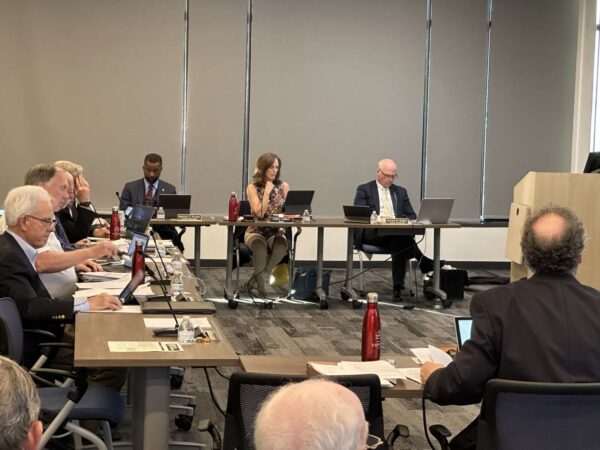
The Town of Vienna has set a tentative timeline for wrapping up the first overhaul of its zoning code since Richard Nixon occupied the White House.
At a May 8 conference session, the Vienna Town Council urged staff to have the rewritten code ready for adoption on Oct. 23 — its final meeting before a new council is elected on Nov. 7.
To meet that deadline, staff will present a complete draft of the new code on June 5 and schedule public hearings for July 10 and 12. Officials with the Department of Planning and Zoning had proposed waiting until late August for the public hearings, since people may be out of town during the summer.
“Staff could…use the summer break to engage with the public and educate them about the contents of the draft, so that they are more able to provide informed testimony,” Planning and Zoning Director David Levy and Deputy Director Kelly O’Brien said in a memo. “While it is likely that many people will be on vacation, staff will provide multiple opportunities both in person and online for citizens to engage when they are available.”
However, the council argued that it would prefer to hear from the public “sooner rather than later” on the update known as Code Create, whose completion was designated as a top priority for 2023.
Faced with a tight timeframe either way, council members noted that July hearings would give staff more time to incorporate the public’s feedback into the final document, and community members could still submit written comments afterwards.
“I think there’s an advantage to going out earlier, because I think I’d like to hear from the public,” Councilmember Ed Somers said.
Before spending over half an hour debating the Code Create schedule, the town council discussed potential new uses in transitional zones — which currently allow little beyond medical offices and massage therapy businesses — and how to handle the mixed-use building at 901 Glyndon Street SE.
The council was particularly split over whether to allow child care centers in transitional zones with a conditional permit. Councilmember Nisha Patel worried that the noise could drive away tenants, while Councilmember Chuck Anderson countered that having child care available in or near their office is a draw for many workers.
Council members suggested creating a zoning district specifically for 901 Glyndon, which is unique in Vienna as a condominium building with ground-floor commercial space in the middle of a single-family residential neighborhood. Town Attorney Steven Briglia warned against “grandfathering” as a “slippery slope.”
“[The building is] always going to be a square peg in a round hole,” he said.
The discussions hinted at the myriad issues that still need to be settled before that Oct. 23 deadline for Code Create, which has been underway since September 2020. The rewrite will shape the town’s future look and development, dictating everything from new zoning districts to lighting standards and bicycle parking requirements.
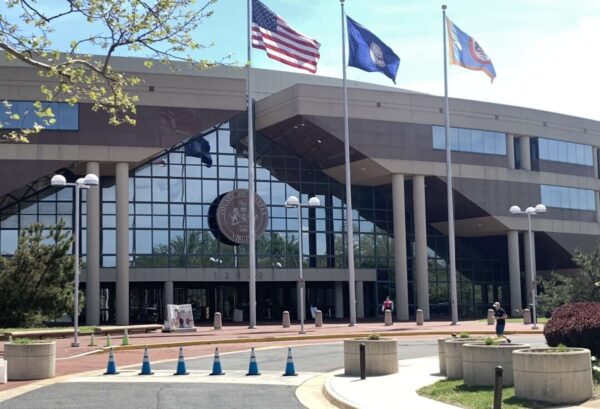
(Updated at 2:25 p.m.) Fairfax County officials are hoping to clear up a legal kerfuffle over its zoning ordinance, which was readopted last week after getting voided by the Virginia Supreme Court earlier this year.
Before readopting a modernized version of the zoning ordinance — known as zMod — on May 9, the county filed a petition for a rehearing in the Supreme Court case Berry v. Fairfax County Board of Supervisors.
The court struck down the ordinance on March 23 — nearly two years after it first took effect — because it was originally adopted during a virtual meeting and therefore violated the Virginia Freedom of Information Act.
The court argued that the county’s state of emergency rules for Covid only allowed virtual meetings on issues “necessary to ensure the continuation of essential functions and services,” which it said didn’t include updating a document last overhauled in the 1970s.
Most residents testifying at an in-person public hearing on zMOD’s readoption last week opposed the update.
Even though zMOD has now been reinstated, the county confirmed to FFXnow that it’s still pursuing the request for a rehearing in the Berry case.
“The Berry opinion was broadly framed and has potential implications that reach beyond zMOD,” a county spokesperson said. “The decision affects numerous localities, among many other public bodies, across the Commonwealth who conducted electronic meetings in good faith reliance on the relevant state legislation to protect their residents during the pandemic.”
The petition argued that the Supreme Court’s opinion not only raised questions about close to two years of zoning actions, but also forced “every public body in the Commonwealth that met electronically during the pandemic…to examine its actions and speculate whether this Court would deem them ‘time-sensitive.'”
In the filing, the county argued that the board acted in “good faith” by holding virtual public meetings in the midst of the pandemic, and they were consistent with Virginia’s limits on public gatherings at the time, which had dropped to 10 people when the board authorized public hearings on zMOD in December 2020.
The county also argues that voiding zMod “casts doubt on years of pandemic-era decisions made in good faith reliance on the budget language.”
Walsh Colluci Lubeley & Walsh, a prominent law firm in the area that handles many Fairfax County land use applications, has also filed two amicus briefs on behalf of the Home Builders of Virginia, the Virginia Association for Commercial Real Estate and the Virginia Land Title Association.
They argue that the Supreme Court’s decision has “already had a significant adverse effect on local governments and private sector entities statewide.”
“The court’s reasoning has cast a cloud over a vast number of land use approvals and permits, not just in Fairfax County but throughout the Commonwealth,” one filing states, adding that “the number of applications potentially impacted by the court’s decision cannot be understated.”
The court could rehear the case if any of the seven justices determine there is good cause.
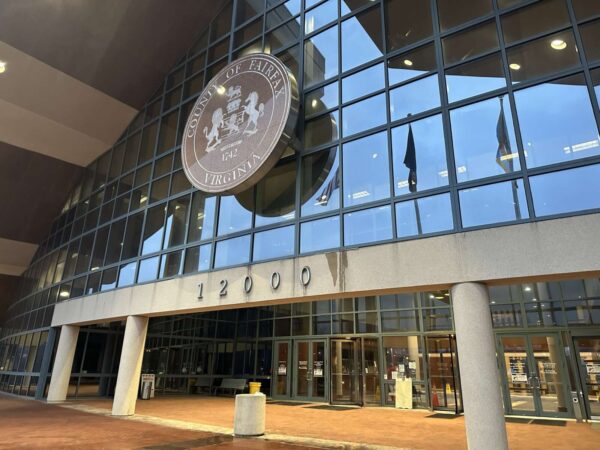
Fairfax County’s zoning ordinance has officially been modernized — for good this time.
The Fairfax County Board of Supervisors unanimously approved the code overhaul known as zMod on Tuesday (May 9) even after overwhelming opposition at the public hearing. The readoption took effect immediately.
Tuesday’s proceedings echoed the board’s consideration of the same plan in 2021 — a vote that the Virginia Supreme Court voided in March. The court ruled that the approval violated open meeting provisions of the Virginia Freedom of Information Act because it came during a virtual meeting.
Board of Supervisors Chairman Jeff McKay said the modernization of the ordinance — which was last updated in 1979 — was long overdue and corrected parts of the document that were discriminatory. McKay said issues that triggered a response in the community will remain on the county’s radar.
“We will continue to monitor those as we have been,” he said.
The board approved a follow-on motion to allow additional opportunity for review at a Fairfax County Planning Commission work session in June — particularly for concerns about allowances for data centers in some areas of the county.
McKay noted earlier in the meeting that zMOD limited where data centers are allowed, banning them from residential districts, but the county has approved nine data centers since the overhaul was first adopted.
Sully District Supervisor Kathy Smith said the planning commission will revisit issues raised at Tuesday’s public hearing as part of a zoning ordinance work program.
Dranesville District Supervisor John Foust conceded that, while the ordinance was not perfect, it should still go through.
“It’s without hesitation that I support adoption,” he said.
Concerns dominating the hearing — losing stable neighborhoods, lack of transparency, detrimental environmental impacts, doubts about county staff’s intentions, and the scope of the overhaul — were similar to criticisms made in 2021.
Some residents revived arguments that eased rules for accessory living units (ALUs) and home-based businesses (HBBs) would destroy the character of stable neighborhoods.
Others said the latest push for zMod was ushered in without transparency and public comment.
Mason District Supervisor Penny Gross said staff “should be celebrated, not castigated” for its work on the zoning revisions, a process that began in 2017.
Springfield District Supervisor Pat Herrity abstained from the vote.
“It was supposed to be a reorganization,” Herrity said. “It ended up being more than that.” Read More

As Northern Virginia continues to cement its position as a global base for data centers, Fairfax County leaders say the time has come to reevaluate the impact of the facilities and, potentially, set some boundaries for the future.
At its meeting this morning (Tuesday), the Board of Supervisors directed county staff to research environmental issues linked to data centers and what’s being done to address them. Staff will also develop guidelines for site locations and the process for approving them.
The unanimously approved motion introduced by Board Chairman Jeff McKay advised staff to report back by the end of this year, but with more centers in the works, some supervisors suggested an accelerated timeline is needed.
“The technology’s changing, the practices are changing, so there may be some things that we need to do even sooner than the end of the year,” Hunter Mill District Supervisor Walter Alcorn said. “I would just encourage us to be flexible and staff to bring things forward when ready.”
Though Silicon Valley remains synonymous with the tech industry, the internet lives in Virginia, which hosts about 35% of the world’s data centers — including 45 million square feet just in Northern Virginia, according to a recent report by real estate developer JLL. As much as 70% of all online traffic passes through Loudoun County, giving it the nickname “Data Center Alley.”
Fairfax County currently has 11 data centers with five more “in the pipeline,” according to McKay. Alcorn said four of the upcoming sites are in his district, which includes the CoreSite campus in Reston and offices for Amazon Web Services (AWS) in Herndon.
With AWS pledging to invest $35 billion for new data center campuses in Virginia, the facilities could “be beneficial from a tax-base perspective and perhaps even a building repurposing perspective,” McKay said in his board matter, which was also sponsored by Mount Vernon District Supervisor Dan Storck and Sully District Supervisor Kathy Smith.
“The region continues to receive requests for more data centers due to our unique location related to the internet’s fiber infrastructure,” McKay said.
However, as the industry’s footprint has grown, so have concerns about the consequences for the environment, local neighborhoods and the power grid.
Citing their impacts on air and water quality as well as electricty usage and greenhouse gas emissions, the county’s Environmental Quality Advisory Council (EQAC) urged the board to develop a plan requiring data centers to use renewable energy “to the extent feasible” and report all emissions and pollutants.
“Actions to mitigate threats to community health and minimize the need for future cleanup of water by County wastewater treatment facilities and Fairfax Water should be undertaken,” EQAC Chair Larry Zaragoza said in the March 13 memo. “Moreover, these steps are important to provide the data centers with clear expectations to reduce environmental impacts.”
The proposed data center plan will build off of updates in the county’s recently voided zoning ordinance, which was scheduled for a public hearing and potential re-adoption today. Read More
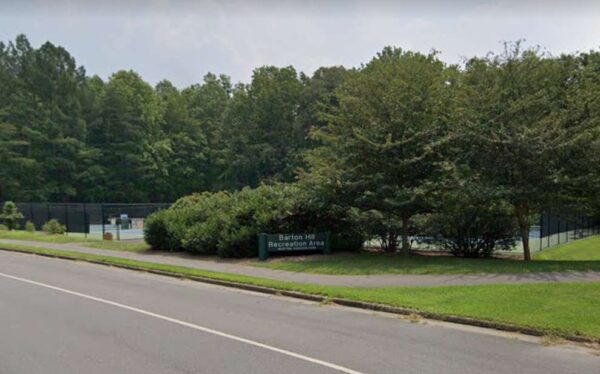
Earlier this spring, the Virginia Supreme Court declared Fairfax County’s modernization of its zoning ordinance (zMOD) invalid because it was adopted at virtual meetings.
In light of the pending re-adoption of the new zoning ordinance, Reston Association is pitching a change that would clarify if additions or enhancements require a Planned Residential Community (PRC) plan — a lengthy process that involves the development of detailed plans and public hearings before the county Planning Commission and Board of Supervisors.
“We went through bit of problem when we tried to add lights to Barton Hill,” RA board president John Farrell said.
The proposed amendment, which was discussed at a Tuesday meeting (April 25), comes following the county’s determination that RA needed a PRC plan to proceed with the lighting component of its planned renovations at Barton Hill tennis court.
RA dropped that portion of the proposal after the Board of Zoning Appeals upheld a county zoning administrator’s decision that a PRC plan was required to add lights in the facility.
With the planning commission set to vote on zMOD again next Wednesday (May 3), RA has suggested that the county add exceptions for when PRC plans are required, including one for additions to existing uses when the addition doesn’t exceed 7,000 square feet or 45% of the existing use’s gross area.
The changes would also exempt minor accessory structures in open space areas, like slides, pathway lighting, heating pools, bathroom facilities and other considerations.
The RA board voted to move forward with proposing the amendment to the county.
In December, RA dropped the lighting component of its Barton Hills project after the zoning appeals board’s decision. The association is now moving forward with plan for the refurbished courts.

